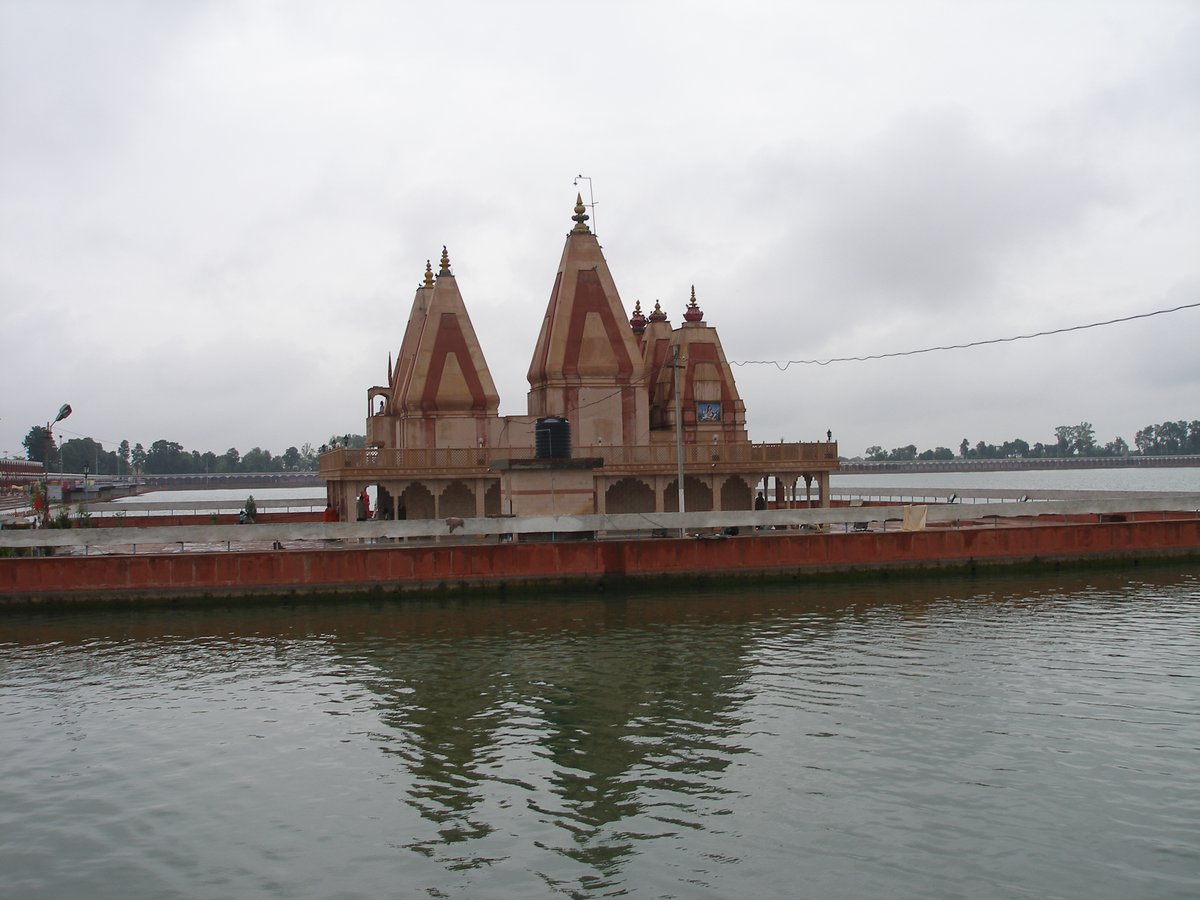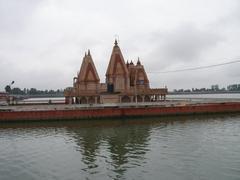
Visiting Kunti Ghat: Hours, Tickets, and Tips
Publication Date: 19/07/2024
Introduction to Kunti Ghat
Kunti Ghat, located in the historic town of Thanesar in the Kurukshetra district of Haryana, India, is a site of immense historical, cultural, and spiritual significance. Named after Kunti, the mother of the Pandavas from the Indian epic, the Mahabharata, this ghat is believed to have been visited by Kunti and her sons during their exile. Situated on the banks of the sacred Saraswati River, Kunti Ghat offers a unique connection to India’s ancient past and serves as a prominent pilgrimage site for Hindus. Over the centuries, Thanesar has been a significant center for both Hinduism and Buddhism, attracting scholars, pilgrims, and rulers, including the renowned Emperor Harsha and Mughal Emperor Akbar. Today, the Haryana government, recognizing the site’s importance, has undertaken various preservation efforts to maintain its sanctity while providing amenities for visitors (Kurukshetra Development Board, Archaeological Survey of India).
Contents Overview
- Introduction
- Ancient Origins and Mythological Significance
- Historical Developments
- Archaeological Findings
- Medieval Period and Mughal Influence
- Modern Era and Preservation Efforts
- Cultural and Religious Significance
- Key Historical Events
- Architectural Highlights
- Visiting Information
- Visiting Hours
- Tickets
- Travel Tips
- Nearby Attractions
- Accessibility
- Preservation Challenges
- FAQ
- Conclusion
Visiting Kunti Ghat, Thanesar - History, Tickets, and Travel Tips
Introduction
Kunti Ghat in Thanesar, India, is a site of immense historical and cultural significance. This guide covers everything you need to know about visiting Kunti Ghat, from its rich history and cultural importance to practical travel information. Whether you’re a history enthusiast or a spiritual seeker, Kunti Ghat offers a unique experience that connects you with India’s ancient past.
Ancient Origins and Mythological Significance
Kunti Ghat, located in the historic town of Thanesar in the Kurukshetra district of Haryana, India, is steeped in ancient history and mythology. The town of Thanesar itself is believed to be the site of the legendary battle of Kurukshetra, as described in the Indian epic, the Mahabharata. Kunti Ghat derives its name from Kunti, the mother of the Pandavas, the central characters in the Mahabharata. According to legend, Kunti and her sons visited this ghat during their exile. The ghat is situated on the banks of the sacred Saraswati River, which is now a seasonal river but holds immense religious significance.
Historical Developments
Thanesar has been a significant center of Hinduism and Buddhism since ancient times. The region around Kunti Ghat has seen various historical developments, including the rise and fall of several dynasties. During the reign of Emperor Harsha (606-647 CE), Thanesar was a prominent center of learning and culture. Harsha, a devout follower of Buddhism, organized religious assemblies at Thanesar, attracting scholars and pilgrims from across the Indian subcontinent and beyond.
Archaeological Findings
Archaeological excavations in and around Thanesar have unearthed numerous artifacts that provide insights into the region’s rich history. According to the Archaeological Survey of India, these findings include ancient coins, pottery, and inscriptions that date back to the Maurya and Gupta periods. The presence of these artifacts indicates that Thanesar, and by extension Kunti Ghat, was an important settlement and a hub of economic and cultural activities.
Medieval Period and Mughal Influence
During the medieval period, Thanesar continued to be a significant religious and cultural center. The region came under the influence of various rulers, including the Mughals. The Mughal Emperor Akbar is known to have visited Thanesar in 1567. His visit is documented in the Akbarnama, the official chronicle of his reign. The Mughal influence is evident in the architectural styles of some of the structures in the region, including those near Kunti Ghat.
Modern Era and Preservation Efforts
In the modern era, Kunti Ghat has continued to be a site of religious importance and a popular destination for pilgrims and tourists. The Haryana government, recognizing the historical and cultural significance of Kunti Ghat and Thanesar, has undertaken various preservation and development projects. These efforts aim to maintain the sanctity of the site while providing amenities for visitors.
Cultural and Religious Significance
Kunti Ghat holds immense cultural and religious significance for Hindus. It is one of the many ghats in Kurukshetra where pilgrims perform rituals and take holy dips, especially during auspicious occasions such as solar eclipses and the festival of Gita Jayanti. The ghat is also associated with various legends and stories from the Mahabharata, making it a place of deep spiritual resonance.
Key Historical Events
Several key historical events are associated with Kunti Ghat and the surrounding region -
- The Battle of Kurukshetra - As per the Mahabharata, the epic battle between the Pandavas and the Kauravas took place in the plains of Kurukshetra. Kunti Ghat, being in close proximity, is believed to have been a witness to this monumental event.
- Emperor Harsha’s Assemblies - The religious assemblies organized by Emperor Harsha at Thanesar attracted scholars and pilgrims, contributing to the region’s prominence as a center of learning and spirituality.
- Mughal Emperor Akbar’s Visit - Akbar’s visit to Thanesar in 1567 highlighted the region’s continued importance during the Mughal era.
Architectural Highlights
While Kunti Ghat itself is primarily a natural site, the surrounding area features several architectural highlights that reflect the region’s historical and cultural heritage. These include -
- Sthaneshwar Mahadev Temple - Located near Kunti Ghat, this ancient temple is dedicated to Lord Shiva and is believed to be the place where the Pandavas prayed before the battle of Kurukshetra.
- Brahma Sarovar - Another significant site near Kunti Ghat, Brahma Sarovar is a large water tank that is considered one of the holiest sites in Hinduism. It is believed to be the site where Lord Brahma performed a yajna (sacrificial ritual).
Visiting Information
- Visiting Hours - Kunti Ghat is open from sunrise to sunset.
- Tickets - There are no entry fees for visiting Kunti Ghat.
- Travel Tips - The best time to visit is during winter months when the weather is pleasant. Pilgrims often visit during religious festivals, so plan accordingly to avoid crowds.
- Nearby Attractions - Besides Kunti Ghat, visitors can explore the Sthaneshwar Mahadev Temple, Brahma Sarovar, and other historical sites in Thanesar.
- Accessibility - Kunti Ghat is accessible by road, with ample parking available for visitors. The nearest railway station is Kurukshetra Junction, approximately 6 km away.
Preservation Challenges
Despite the efforts to preserve Kunti Ghat and its surroundings, the site faces several challenges -
- Environmental Degradation - The seasonal nature of the Saraswati River and pollution pose significant threats to the ecological balance of the area.
- Urbanization - Rapid urbanization and development in and around Thanesar have led to encroachments and the loss of historical sites.
- Tourism Pressure - The influx of tourists and pilgrims, especially during peak seasons, puts pressure on the infrastructure and can lead to the degradation of the site.
FAQ
- Q - What are the visiting hours for Kunti Ghat?
- A - Kunti Ghat is open from sunrise to sunset.
- Q - Is there an entry fee for Kunti Ghat?
- A - No, there are no entry fees for visiting Kunti Ghat.
- Q - What is the best time to visit Kunti Ghat?
- A - The best time to visit is during the winter months when the weather is pleasant.
- Q - Are there any nearby attractions?
- A - Yes, visitors can also explore the Sthaneshwar Mahadev Temple and Brahma Sarovar nearby.
Conclusion
Kunti Ghat, with its rich historical background and deep cultural significance, remains a vital part of India’s heritage. The ongoing efforts to preserve and promote this site are crucial in ensuring that future generations can continue to connect with its historical and spiritual legacy. For more detailed information on the history and significance of Kunti Ghat, you can refer to sources such as the Kurukshetra Development Board and the Archaeological Survey of India.
For more updates on historical sites in India, download our mobile app Audiala or follow us on social media.
Summary and Key Points
Kunti Ghat in Thanesar stands as a testament to India’s rich historical and cultural heritage. From its legendary connections to the Mahabharata and the significant events during Emperor Harsha’s reign to its continued importance during the Mughal era, Kunti Ghat offers visitors a profound experience of India’s past. The ongoing preservation efforts by the Haryana government ensure that future generations can continue to connect with its spiritual and historical legacy. Whether you are a history enthusiast, a spiritual seeker, or simply a traveler looking to explore India’s cultural treasures, Kunti Ghat provides an enriching and memorable experience. For more detailed information, refer to the Kurukshetra Development Board and the Archaeological Survey of India.
Sources and Further Reading
- Visiting Kunti Ghat, Thanesar - History, Tickets, and Travel Tips, 2024, Author (Kurukshetra Development Board)
- Discover the Cultural and Historical Significance of Kunti Ghat in Thanesar - Visiting Hours, Tickets, and More, 2024, Author (Archaeological Survey of India)
- Complete Visitor Guide to Kunti Ghat, Thanesar - Best Times, Tickets, and Travel Tips, 2024, Author (Kurukshetra Development Board)
